Verdict
In a world of 2.0-litre diesel executive saloons the petrol-electric Lexus GS300h is a genuine alternative to the mainstream and that in itself should be welcomed.
Nothing in the segment can rival its kit-per-buck ratio or its miserly on-paper running costs – although, admittedly, diesel alternatives are still likely to perform better on long motorway slogs. Make no attempt to press the Lexus too hard and it’ll reward you as an unruffled, indefatigable travelling companion.
If it’s not got quite the urgency you want but you still want to opt out of the Jaguar and Germanic big three car park bragging histrionics, there’s still the brisker GS450h to consider. Just don’t expect that to be a-thrill-a-minute either.
Conclusion
The updates for the 2016 model year bring a welcomed change for the GS sedan. No longer does it look subtle and soft-spoken – no, the GS is now an in-your-face sedan with attitude. Getting the F Sport package only increases that attitude. The GS now stands out rather than blending in. It’s more eye candy than sensible sedan. And that’s exactly what Lexus needed the GS to become.
The competition is strong in this full-size luxury sedan class, so standing out is important. Disenchanted BMW and Mercedes owners might be giving Lexus a close look – and from what I’ve seen of the GS 450h F Sport, they should be pleasantly surprised by what they find.
All told, the GS 450h F Sport makes for a great combination of sport and hybrid efficiency. It combines a solid suspension system with a powerful drivetrain, RWD, and a respectable CVT for a luxury sedan that isn’t afraid of curvy roads. While it might not be the master of the “hybrid” or “sport” trades, the GS 450h F Sport does a good job at being the jack of them.
2016 Lexus GS Performance
There are three available engines in the 2016 Lexus GS. The newest on the line is the turbocharged four-cylinder that comes under the hood of the GS 200t. Packing 241 hp and 258 lb-ft of torque and paired with an eight-speed transmission, it can hit 60 mph in 7.2 seconds.
The second engine comes in the GS 350. The V6 engine packs 311 hp and 280 lb-ft of torque and is mated to an eight-speed transmission. The GS 350 is comes with both an Eco and Sport mode as well as a Sport+ mode on higher trims. Rounding out the numbers is a 0-to-60 mph time of 5.7 seconds.
The third and final engine on the Lexus GS lineup is the GS 450h hybrid that packs a V6 engine with a 147 kW motor and 30 kW battery pack. In all it produces 338 hp and delivers the strongest acceleration of the line.
| | Performance | | |
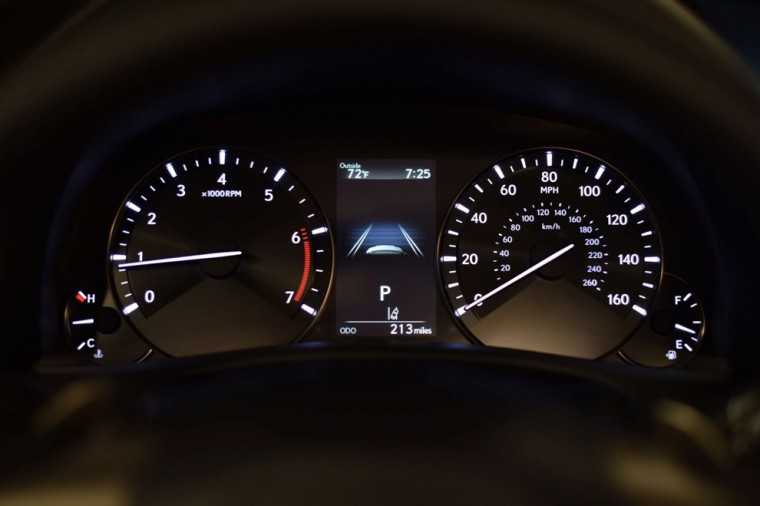
Performance
Speaking of the economy, there’s now a stop-start system designed to save fuel on both the 200t and 350. The bigger GS 350 with all-wheel drive gets 22 miles per gallon on the combined run while its two-wheel driven sibling adds 1 mpg more increasing it to 23. As you’d expect the 200t is the most economical with a 26 mpg return. The F sports trims of both versions lose on average about 1 mile per gallon which isn’t bad at all.
Besides the two already mentioned models, there are also 450h hybrid and F models. In the case of the hybrid, we are getting 338 hp and 29/34 mpg city/highway which is a nice increase over the standard version. If you want more power and even sportier sedan than the F-type is the choice for you. Its 5.0 liter V8 powerplant will send 467 hp to wheels allowing it to reach 60 mph from a standstill in 4.4 seconds while reaching the maximum of 168 mph.
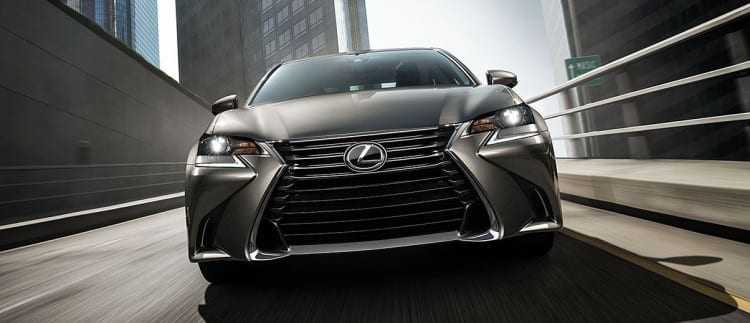
Source: lexus.com
This is a sporty sedan first and foremost, so handling and driver involvement are key here. The GS manages to be sporty and confidence inspiring without sacrificing what makes it best, ride comfort. Yes, it may lose in terms of dynamic capabilities to the likes of the E-class or the 5-series, but in terms of ride quality and refinement, it trumps them both. It’s typical Lexus really. A smooth ride and next to no wind or road noise is something to expect here.
The base engines aren’t that pleasant sounding, especially the 4-cylinder, but they are relatively quiet. Haters of the four-cylinder in a large luxurious sedan will be impressed. The relatively small engine manages to pull the big chassis with ease. More power can, of course, be found in the naturally aspirated V6. Although that lump has been in production for more than 10 years, it still feels up-to-date and modern. When we add hybrid and V8 options to the list we can agree that GS completes the offer very successfully and gives almost every driver something to choose.

Source: lexus.com
Those in search for even better handling characteristics can opt for the F Sports package. It brings a rear-wheel steering system as well as variable gear ratio steering system. The F Sport also rides on bigger 19-inch wheels and has a harsher suspension, but it still isn’t enough to upset ride comfort. The F Sport is certainly nice, but not something mandatory to get a good handling vehicle from the GS.
2016 Lexus GS Safety
The 2016 Lexus GS line earned “Good” ratings when tested by the Institute for Highway Safety (IIHS). It wasn’t tested in the small-overlap frontal test and the National Highway Traffic Safety Administration hasn’t tested the sport sedan yet.
In all, there are 10 airbags, Bluetooth, and an entire set of tech-savvy safety options. Active cruise control with pre-collision warning system and braking intervention, blind-spot monitors, lane-departure warning system, and lane-keep system are just a few of the available features.
Standard Safety Features
- EDriver and front passenger knee airbag
- Force-limiting seat belts with pretensioners
- Vehicle Dynamics Integrated Management (VDIM) system
- Front and rear side-curtain airbag Supplemental Restraint System (SRS)
- 3-point belts for all seating positions, including rear center position and height adjustable front shoulder belt anchors
- Four-channel, four-sensor Anti-locking Braking System (ABS) integrated with Brake Assist (BA), Vehicle Stability Control (VSC), and Electronic Brake-force Distribution (EBD)
- Seat-mounted side airbag SRS for front and rear seats
- Impact-dissipating upper interior trim
- Vehicle Stability Control (VSC) system
- Tire pressure monitor system (TPMS) system
- Daytime Running Lights (DRL)
- Driver and front passenger airbag
- Electronic Parking Brake with AUTO feature
- Automatic locking retractor (ALR)/Emergency Locking Retractor (ELR) seat belt function on all seating positions except driver (ELR only)
- Supplemental Restraint System (SRS) with occupant-detecting front passenger airbag cutoff mechanism
- Front and rear energy-managing crumple zones
- Rear back-up camera with static guidelines
- Blind Spot Monitor with Rear Cross Traffic Alert
| | | | | Safety
Drive Green: Learn more about hybrid vehicles available from Lexus
Choose Your Midsize Sedan
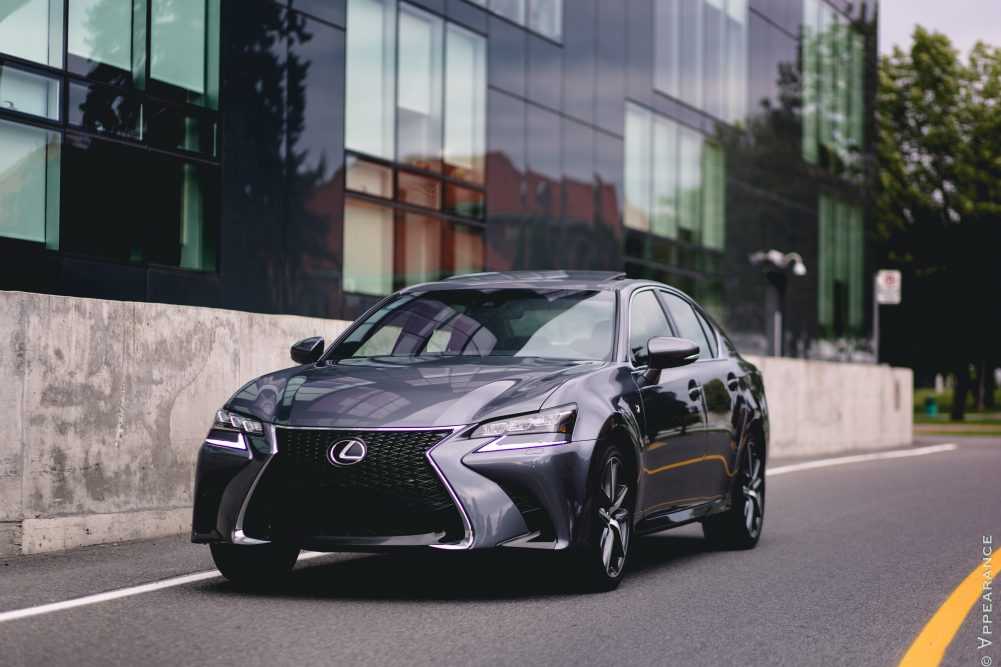
So, how different is this grey midsize Lexus compared with the other grey midsize Lexus I reviewed a month ago? Well, for starters, this one, the GS, is a lot more driver-focused than the Toyota Avalon-based ES you saw me drive in that previous review. While the ES was soft, quiet and wallowy in corners, the GS is much stiffer, reactive, and athletic. Under the hood lies the same 3.5-liter V6, essentially the one used in all V6-powered Lexus vehicles, but this time around it’s slightly retuned to develop a healthy 311-hp and 280 lb-ft of torque (versus 268/248 in the ES). Also, unlike the ES which is a front-wheel drive car, the GS has its engine mounted longitudinally, which means it sends its power to the rear first. Ironically, only the American market gets the rear-wheel drive GS, with all-wheel drive offered as an option. Us Canucks are stuck with AWD as the sole powertrain available for non-hybrid models; which makes sense, considering our climate and road conditions.

Still, I do wish we’d get the RWD GS.
Nevertheless, it’s interesting how Lexus has split up its two midsize sedans, which both offer completely different personalities and overall character. And to be totally honest, even though the GS sells for a good $10 000 more than the ES, it’s by far my favourite car among the Lexus lineup. While I yearn to get behind the wheel of the almighty GS-F, Lexus’ official “M5 fighter”, I must say I was rather impressed with the “ordinary” GS’ built-in athleticism and old-school way of putting the power down. Somehow, and I know I promised I wouldn’t say this, the GS350 feels like an early 2000’s BMW 5-series to drive.
Urgh – so long for being original.
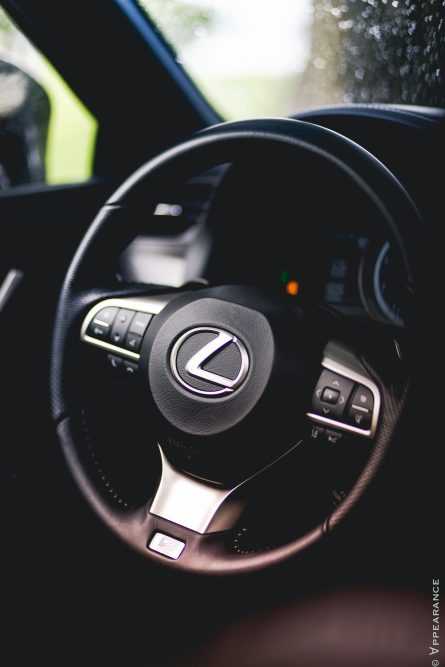
But then again, that’s not a bad characteristic, isn’t it? Notice how I didn’t compare the GS350’s driving feel to a new BMW? Trust me, that’s a good thing. Because although the GS may seem complicated with its futuristic headlights and gigantic LCD screen in the middle of its dashboard, there’s nothing revolutionary about how it delivers power. All competition in this segment, except maybe Acura, offer turbocharged propulsion. And although the American market does get a 2.0L turbo option, the GS can still be powered by an old fashion naturally aspirated V6 – something that’s becoming a rare exception in this day and age. And in the GS, that V6 loves to rev.
Competition
BMW ActiveHybrid 5
The 5 Series is about as iconic as a premium sedan can get. It offers a range of options and tons of standard features that make it worthy of the BMW badge. For those wanting the greenest 5 Series, BMW offers the ActiveHybrid 5. It comes powered by a turbocharged, 3.0-liter inline six-cylinder making 300 horsepower. A lithium-ion battery pack offers full-electric power up to 37 mph, while an eight-speed automatic transmission sends power to the rear wheels. The EPA rates the ActiveHybrid 5 at 23 mpg city and 30 mpg highway.
Prices for the 2016 BMW ActiveHybrid 5 start at $62,100.
Read our full review here.
Porsche Panamera S E-Hybrid
Like the BMW 5 Series, the Panamera is available in a variety of powertrain configurations, including a hybrid. Porsche’s hybrid, however, is of the plug-in variety and offers 20 miles of all-electric range before the gasoline engine kicks in . Speaking of which, the gas engine is a supercharged 3.0-liter V-6 making 333 horsepower. Add in the 95-horsepower, 229-pound-feet of torque electric motor, and the Panamera boasts a totally output of 416 horsepower and 435 pound-feet of torque. Power is routed through an eight-speed automatic transmission to the rear wheels.
Porsche is proud of the E-Hybrid, though, and its base price starts at $99,975. That’s quite a bit more expensive than either the Lexus or BMW, but the Porsche is quite a bit more powerful.
Read our full review here.
So bigger changes for the Lexus GS’s cabin then?
You’d think so, but no. Be under no misapprehensions, mind, the cabin quality is superb – not in terms of Audi-aping squidgy plastics but in the sheer solidity of its construction. It also packs a standard equipment roster that’s bristling with features its competitors leave on the options list.
Even the entry-level GS300h Executive Edition, weighing in at £33,495, enjoys the firm’s uprated suite of active safety systems, heated and electrically adjustable leather seats and steering wheel, keyless entry, a 12-speaker audio system and bi-LED headlamps. Spec a BMW 520d SE to a similar amount and you’ll be forking out the thick end of an extra £8,000.
It’s not all rosy, though. That fiddly Remote Touch Interface toggle remains the key method for interacting with the 12.3-inch wide infotainment screen, while the sat-nav itself is blighted with graphics that could have been designed in MS Paint.
Plus there’s a mish-mash of switchgear types with rotary dials for this, buttons for that and a lever for the other. By which we mean the CVT gearbox.
Interior
The interior is typical Lexus too. Materials are chosen from the best options, and there isn’t a single harsh material or surface within sight. Everything’s made from leather and there are beautiful wood and aluminum inserts found throughout the car’s cabin. The materials used certainly rival those of its German competitors, but the fit and finish go way beyond what even they offer.

Source: lexus.com
The front seats are comfortable and supportive, and you sit in the seat rather than on it since they will firmly hug you and keep you in position all the time. The F Sport gives the seats even more lateral support with adjustable side bolster, although the normal seat is perfectly fine too and offers ample settings for adjustability. The back has enough legroom and headroom for three adults, but a sporting luxury sedan like this is best with just two passengers in the back so that both can enjoy the ride of their life.
As facelifts go, it’s rather subtle isn’t it?
Lexus’s styling is going through something of a dramatic transition at the moment, evidenced by the IS, RC and recent Detroit debutant, the LC 500, all following the LFA’s angular form. By contrast the tweaked GS looks a tad podgy about the flanks, but its extremities have been fettled.
The alterations are more obvious front-on, with the grille now being even larger and protruding further forwards with greater visual aggression. It’s somewhat at odds with the GS’s character, it transpires.
While the new prow errs – just – on the right side of garishness, the headlamps have enjoyed a less successful revamp. There’s now a trio of LED projectors forming the main unit, while the signature Nike-esque swoosh of daytime running lights now sits separately within the bumper moulding. It looks incongruous on the GS’s snout, akin to similar sports company symbology adorning the sneakers of a septuagenarian.
Things are more restrained out back with the light units remaining the same shape as before, albeit with new LED-dominated lighting within their confines.
2016 Lexus GS Interior
Like the exterior, the interior of the 2016 Lexus GS remains steady with a horizontal dashboard. LED ambient lighting glows softly in the background while the front touchscreen display draws eyes. To top it off, the Lexus GS line makes use of real wood trim and padded leather panels for that quality look and feel.
2016 Lexus GS Interior Photos:
Interior available on the GS 200t
- Interior Features: Automatic climate control, LED ambient lighting, Steering wheel tilt and telescopic adjustment, Driver multi-adjustable power seat, Rear window defogger with auto-off timer, Passenger multi-adjustable power seat, Aluminum-alloy “Lexus”-stamped scuff plates on all door sills, Fold-down rear center arm rest, Dual zone front climate control, Rear seat climate control vents, Interior day/night electrochromic rearview mirror, Steering wheel-mounted controls, Wrapped instrument panel with contrast stitching, Power sunroof/moonroof, Leather-trimmed steering wheel, Interior air filter
- Radio and Technology: Voice-activated controls, 5.1 surround sound, Bluetooth technology, Homelink universal garage door opener, 12-volt power outlet, Lexus Memory System, Multi-function remote, Electronic parking aid – camera, Auxiliary input jack, Lexus Personalized Settings, 12 speakers, Satellite radio, Remote Touch Interface, AM/FM/DVD with HD radio and WMA/MP3 capability, Smart Key, Optional Mark Levinson audio system, USB input port, Keyless entry
Interior available on the GS 200 F SPORT
- Interior Features: Striated aluminum trim, F SPORT aluminum pedals and door scuff plates, Rear window sunshade, Heated front seats, Perforated leather trim and black headliner, 16-way power sport driver seat
- Radio and Technology: Adaptive cruise control
Interior available on the GS 350
Radio and Technology: Lexus Enform Destinations, Lexus Insider, Lexus SD Navigation System with 12.3-inch High-Res Screen, Lexus Enform App Suite
Interior available on the GS 350 F SPORT
- Interior Features: 16-way power sport driver seat, striated aluminum trim, F SPORT aluminum pedals and door scuff plates, Rear window sunshade, Perforated leather trim and black headliner, Heated front seats
- Radio and Technology: Adaptive cruise control
Interior available on the GS 450h
- Interior Features: Power door locks, Leather heated steering wheel, Padded instrument panel, Laser Cut Wood trim, Leather-trimmed seats, Rear A/C vents on back of center console, Heated/ventilated front seats, LED ambient lighting, Power rear sunshade, Fold-down rear center arm rest, One-touch up/down function with jam protection, Power tilt-and-telescopic steering wheel, Aluminum-alloy “Lexus”-stamped scuff plates on all door sills, Electrochromic rearview mirror with compass, 10-way power driver and front passenger seats, Contrast stitching, Steering wheel audio and multi-information display controls, Leather-trimmed shift knob, Push-button engine start
- Radio and Technology: Lexus Memory System, Lexus SD Navigation System with 12.3-inch High-Res Screen, 12 speakers, Auxiliary input jack, Advanced voice recognition, HD Radio with iTunes tagging, Lexus Personalized Settings, Lexus Inform Destination Services, HomeLink universal garage door open, 5.1 surround sound, SmartAccess keyless entry, 8-inch high-res multi-information touchscreen, Bluetooth technology, Cruise control, AM/FM/DVD/CD player with WMA/MP3 capability, Remote Touch Interface, Lexus Insider, Lexus Enform App Suite, USB input port
Interior available on the GS 450h F SPORT
Interior Features: Striated aluminum trim, Leather-trimmed seats, 16-way power sport driver seat, Perforated leather trim and black headliner, F SPORT aluminum pedals and door scuff plates
| | | | Interior |
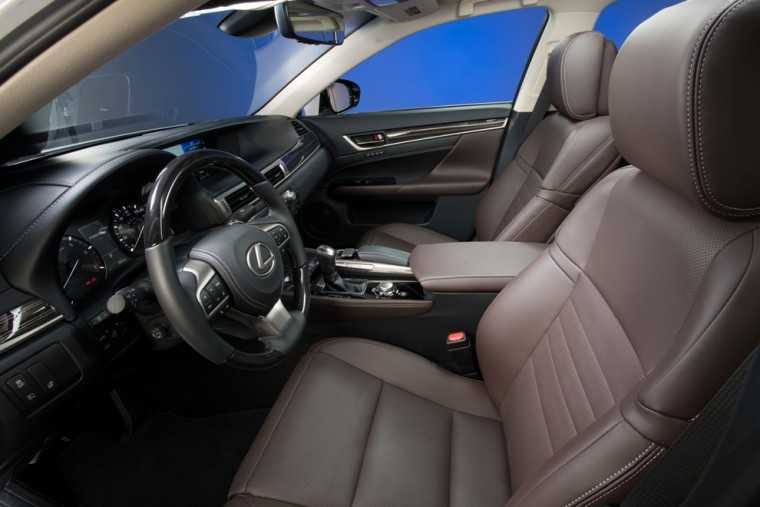
Driving Dynamics
What did we like? The 2016 Lexus GS 200t does ramp up the fun-to-drive meter. On the twisty mountain curves west of Denver, the sports sedan was a willing partner as we pushed it hard around the corners. The F Sport package seemed to elevate its road-hugging prowess and kept it firmly planted. The F Sport’s larger 19-inch wheels, stiffer suspension, and performance-oriented summer tires do diminish comfort somewhat, but that’s why you buy the performance package.
What we didn’t like? We found there’s a delay when you step on the gas pedal. The turbocharger does have some lag and it takes a moment for the turbocharger and transmission to decide what to do. Lexus offers paddle shifters which helps the GS 200t override any issues with the transmission and turbo disconnect.
The ride is reasonably smooth on the open road and the cabin is quite like you would expect. Overall, the new turbo four-cylinder is a good option for driving enthusiasts and it still delivers good fuel mileage, if you can keep your foot out of the pedal.
Обзор Lexus GS 200t 2016
Очередной Конкурс элегантности в Пеббл-Бич, состоявшийся в середине августа в американском штате Калифорния, стал местом презентации обновлённого седана Lexus GS. Там же была представлена по-своему привлекательная модификация, оснащённая 2-литровым мотором с наддувом. Автомобиль получил светодиодные фары, модифицированный передний бампер с фирменной решеткой радиатора в форме веретена с хромированной окантовкой, изменённые задние фонари и пороги.
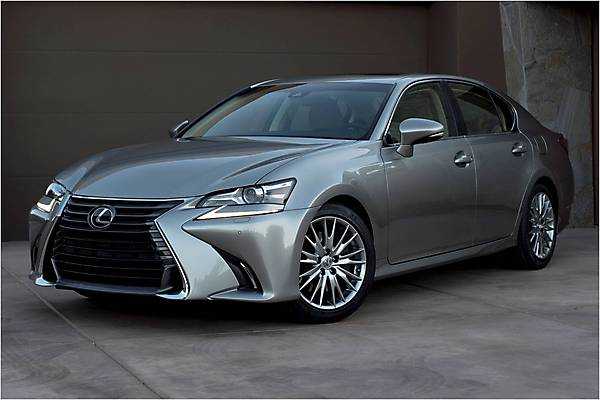 Lexus GS 200t (2016)
Lexus GS 200t (2016)
Список возможных оттенков кузова пополнился расцветками Matador Red Mica, Nightfall Mica и Ultrasonic Blue Mica 2.0. Кстати, окраска многослойная, а цветовые темы ранее использовались лишь для концептов японской марки.
Lexus GS 2016 модельного года не остался без обновлённых колёсных дисков размерностью 18 и 19 дюймов. Для интерьера предусмотрена новая отделка древесиной грецкого ореха с алюминиевыми акцентами. В часах, расположенных на центральной консоли, имеются светодиодные индикаторы. Регулировка часового пояса осуществляется при помощи данных GPS-навигации. В состав современной мультимедиа системы Lexus Enform с голосовым управлением входит дисплей диагональю 12,3 дюйма.
Особый интерес представляет модификация Lexus GS 200t. Под капотом седана получил прописку бензиновый 4-цилиндровый турбомотор объёмом 2 литра, генерирующий 241 лошадиную силу мощности с крутящим моментом до 350 Нм. Двигатель работает в паре с 8-ступенчатой автоматической коробкой передач, реализующей тягу колёсами задней оси. По предварительным данным, в загородном цикле расход топлива роскошного «японца» составляет всего 7,1 литра на сто километров пробега.
Новый GS 350 укомплектован V-образной «шестёркой» объёмом 3,5 литра с отдачей 311 лошадиных сил и 380 Нм. Ранее мощность была 306 лошадиных сил. Тягу реализует 8-диапазонный «автомат», а привод может быть полным с распределением крутящего момента между осями в соотношении 30/70 в штатном режиме. Понятное дело, с преимуществом задней оси, но при необходимости соотношение изменяется до равного для оптимального сцепления с дорогой.
Флагман модельной линейки — гибрид GS 450h. Здесь 3,5-литровый мотор V6 дополнен электродвигателем, суммарная мощность силовой установки равняется 338 л/с. Все данные приведены для 2016 Lexus GS, предназначенного для продаж в США, но и до России обновлённый седан обязательно доберётся.
По материалам cofx.ru и др.
A CVT? Not the kind of car that enjoys being hustled along I guess?
Lexus’s forte is delivering cars that go about their business effortlessly, responding best to gentler driver inputs in order to coax the greatest degree of efficiency from the petrol-electric drivetrain.
A raft of modifications have been introduced to reduce the four-cylinder Atkinson cycle engine’s thirst for petrol as well as subduing NVH levels. Of greater interest to a company car driver’s bank balance, however, is that the GS300h Executive Edition emits just 104g/km of CO2 – partly thanks to its 17-inch rims. There’s no 3% diesel Benefit-In-Kind surcharge here either.
Despite a combined power output of 220bhp the Lexus’s portly 1730kg girth stymies performance, as it requires nine seconds to reach 62mph from a standstill. Still, the claimed fuel economy is 64.2mpg on the combined cycle, so a real-world figure in the low-40mpgs is possible providing you don’t drive it with too much verve.
You’re not going to want to push on aggressively in this Lexus, anyway. Eager application of the throttle induces that familiar shrill protest from under the bonnet, as the CVT results in the stereotypical ‘high engine speed, moderate acceleration’ effect, but the electronics soon calm the transmission’s urges and serenity is resumed.
Until you approach a series of bends at speed, that is. The GS will adhere well through left-right-left flicks but there’s ample body roll to upset the comfort equilibrium. Nevertheless, ride quality when cruising is impressive.
Lexus also claims to have revised the steering to deliver a more feelsome experience but that’s not entirely successful either. BMW and Jaguar alternatives serve up a much meatier experience at the wheel, but the GS? If Quorn made steering racks…
News
All Lexus GS news
NewsBell Tolls for the Lexus GSLexus has two midsize sedans in its lineup, but pretty soon that will no longer be the case. After three years of rumours, Toyota’s luxury brand has announced that GS production will end in August. The model was initially launched in 1993. As a result, the slightly less spacious and …
News2016 Lexus GS gets boosted 4-cylinder, exterior makeoverThe Lexus IS isn't the only sedan in the brand's lineup to get a turbocharged shot in the arm for 2016, with the larger GS getting the same treatment heading into next year. The midsize GS is getting a makeover for the 2016 model year, sporting a more pronounced version …
NewsLexus Reveals Updated GS And LX Models At Pebble BeachThe Pebble Beach Concours d’Elegance in Monterey, California was the backdrop for the unveiling of the 2016 Lexus GS midsize sedan and the 2016 Lexus LX full-size SUV. Surprisingly, in addition to a restyled front fascia with LED headlights, revised taillights and rear trim, new alloy wheel designs and new …
DetroitHere Is The 2016 Lexus GS F (with press release)TORRANCE, Calif. — Jan. 6, 2015 – Lexus is yet again showing its sporty disposition and rumbling into Detroit. The luxury vehicle manufacturer has announced the much-anticipated GS F performance sedan, which combines a refined four-door package with the speed and agility of a premium sports car, will be revealed …
MontrealLexus debuts 2013 Lexus GS at the Montreal International Auto ShowA Sport Sedan with World-Class Luxury and Evocative Design Shows New Identity of Lexus Outstanding Driving Dynamics and Innovative Technology Combined Priced to be the most competitive choice in segment At the 2012 Montreal International Auto Show, Lexus continues to deliver progressive luxury and a fresh, evocative design with the …
New ModelsLexus announces pricing for the best in segment, new 2013 Lexus GS 350 luxury performance sedanLexus adds performance, style, content, technology for the new 2013 model year, even as it prices the GS 350 to be the most competitive choice in the segment Go ahead: delight your inner performance car driver. The fourth-generation Lexus GS 350 – all new for the 2013 model year – …
TokyoLexus to Display ‘GS’ Series and ‘LFA Nürburgring Package’ at Tokyo Motor ShowLexus will display the next-generation «GS»1 series—its premiere in Japan—and the «LFA Nürburgring Package» at the 42nd Tokyo Motor Show. The show is to be held from November 30 to December 112 at Tokyo Big Sight in Koto Ward, Tokyo. Lexus has made it its mission to provide value that …
Los AngelesAll-New 2013 Lexus GS Family Makes Auto Show Debut at Los Angeles Auto ShowSport Sedan with World-Class Luxury and Evocative Design Shows New Identity of Lexus Exceptional Driving Dynamics and Innovative Technology GS 450h Fuel Economy Expected To Be Improved by More Than 30 Percent F SPORT Package Features Dynamic Handling with F SPORT Tuned Adaptive Variable Suspension The bold new Lexus GS …
Interior
Lexus designers didn’t forget about the interior with the 2016 updates. The sedan now features a new steering wheel, updated IS-like gauge cluster, updated software for the Enform system, and new interior trim and color choices.
From behind the wheel, you’ll first notice the, well, the wheel. It features a slew of controls for things like the radio, driver information screen in the gauge cluster, voice command and phone buttons, and controls for the adaptive cruise control. Its new design is also cleaner and more refined than the outgoing wheel. Then there’s the gauge cluster.
Gone are the two analog gauges with the small driver information screen. A gauge cluster that recalls the Lexus IS sedan and RC coupe’s cluster, both of which were inspired by the mighty Lexus LFA, replaces it. Unlike the IS and RC, the GS’ center gauge does not slide sideways to reveal a third TFT screen. It remains stationary, but its display changes depending on which drive mode is currently selected.
The screen to the left gives a host of vehicle information, including energy flow (hybrid only), a g-meter (F Sport only), radio and phone info, tire pressure, and any system warnings. Controls for this screen are on the right stalk of the steering wheel. To the right of the center screen are two analog gauges for coolant temperature and fuel level.
Sitting top and center of the dashboard is a 12.3-inch infotainment screen. Introduced in 2015, the large screen carries over for 2016, but with updated software that allows for a full-screen map mode and more viewing options in the split screen mode. There’s also new menu buttons along the right side of the screen for faster navigation. As I mention in the video walk-around, I’ve always though Lexus’ Enform systems prematurely outdated looking. This version, however, seems to escape that feeling despite its similarity to previous versions. I just liked it better.
Regardless of my opinions, the Enform system works well and is fairly straight forward – even for non-techy people. The mouse-like controller on the center console is the main input method. With some practice, the joystick is easy to use. I will say though, that turning the joystick’s feedback down to its lowest setting makes it even easier to use. Maximum feedback makes the joystick vibrate like crazy.
My tester’s interior came with the optional Rioja Red leather seats and Naguri Aluminum trim. The combination furthers the car’s sporty feel. I really love the 3D appearance and texture of the aluminum trim. It gives the car a more exclusive feel than the traditional wood accents.
In practice, the interior is wonderfully useful. The driver’s seat has 16-way power functions that allow for minute adjustments for the perfect fit. The power-operated steering column further allows for the perfect driving position. The HVAC system is easy to use, but only after learning the smallish buttons. I really enjoyed the automatic temperature controlled seats, which adjusts to match the temperature setting from the air conditioner.
Rear seat comfort is also very good. Leg and headroom are generous, and a folding center armrest and air vents keep passengers happy. The driver also has control of a power-operated sunshade that covers the rear window.



























